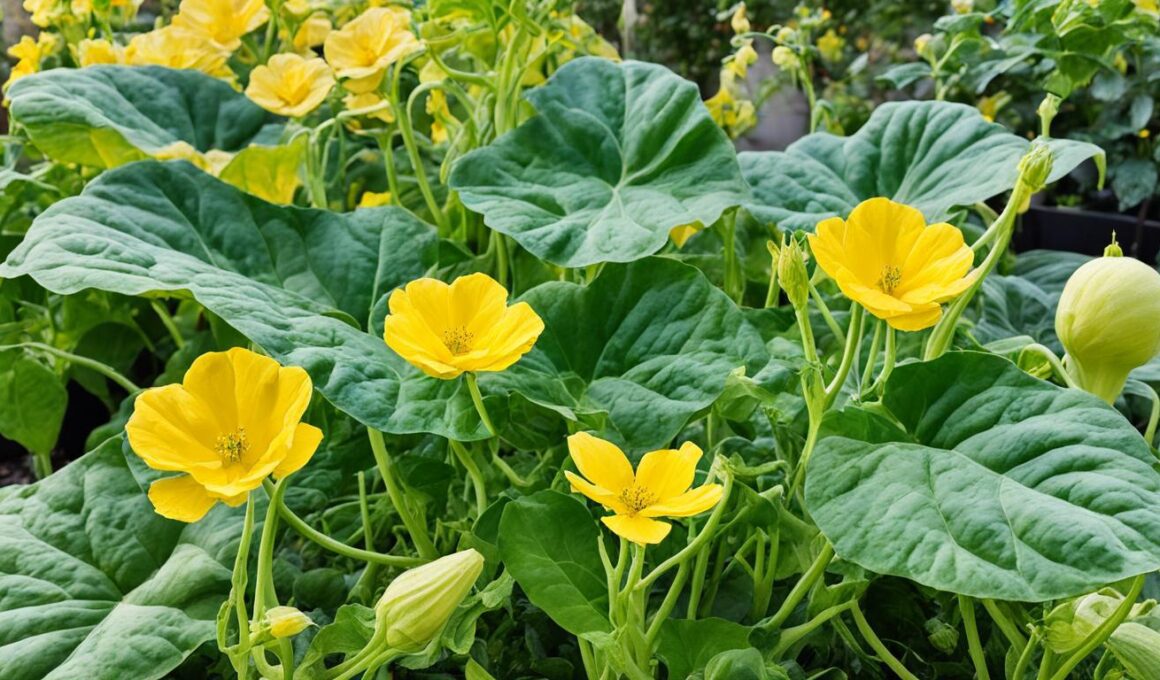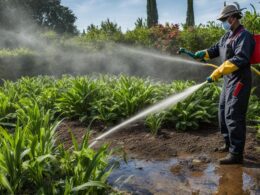Welcome to our guide on growing spaghetti squash! If you’re a fan of winter squash and want to try your hand at growing your own, spaghetti squash is a great choice. It goes through several stages of growth before reaching its delicious and versatile state. In this section, we’ll walk you through each stage, from planting to harvesting, and provide you with essential tips for successful growth.
Winter squash, including spaghetti squash, starts its journey with the planting stage. You can start the seeds indoors or plant them directly into the garden once the danger of frost has passed. Next comes germination, where the seeds sprout and develop roots. This stage typically lasts around 2 to 10 days, depending on various factors such as temperature and soil moisture.
Once the seeds have germinated, the seedling stage begins. This is when the seedlings develop true leaves and grow sturdier. From there, the plants enter the vegetative phase, where their vines grow rapidly, producing male and female flowers. It’s during this phase that the magic of reproduction happens, with the female flowers being pollinated and developing into the familiar spaghetti squash fruits.
Finally, we arrive at the most exciting stage: harvesting. Harvested spaghetti squash should have a deep yellow skin, a hard rind, and a dry brown stem. This indicates that the fruits are fully mature and ready to be picked. It’s important to wait until this stage to ensure maximum flavor and texture in your squash.
Now that you have a better understanding of the growing stages of spaghetti squash, let’s delve into the tips for successful cultivation. Read on to discover how to provide the ideal growing conditions, address pest and disease issues, and achieve a bountiful harvest of this nutritious winter squash.
Tips for Successful Spaghetti Squash Growing
To successfully grow spaghetti squash, it’s important to provide the right growing conditions. Follow these tips to ensure a successful harvest:
- Soil: Choose a location with loose, fertile soil that drains well. Spaghetti squash thrives in soil with a pH level between 6.0 and 6.8.
- Watering: Maintain consistent soil moisture by watering regularly. Avoid over-watering, as it can lead to root rot. Monitor the soil moisture level and adjust watering accordingly.
- Fertilization: Help your spaghetti squash plants grow healthy by applying a balanced fertilizer once or twice during the growing season. Follow the manufacturer’s instructions for application rates and timings.
- Pest Control: Protect your plants from common pests such as aphids, squash bugs, and cucumber beetles. Use organic pest control methods like introducing beneficial insects or applying insecticidal soap.
- Disease Control: Prevent fungal diseases like powdery mildew and downy mildew by practicing good sanitation and proper plant spacing. Apply organic fungicides if necessary, following the instructions on the product label.
- Harvest: The harvesting stage is crucial for enjoying delicious spaghetti squash. Wait until the squash has a deep yellow skin, a firm rind, and a dry brown stem before harvesting. This ensures that the squash is fully mature and ready to be enjoyed.
Conclusion
Growing spaghetti squash involves several stages, from planting to harvest. By following the tips and guidelines for each stage, you can successfully cultivate this unique winter squash. Providing the right soil conditions, proper watering and fertilization, effective pest and disease control, and harvesting at the right time ensures a bountiful yield of delicious and versatile spaghetti squash.
Spaghetti squash makes a nutritious and flavorful addition to any garden. Its versatility allows you to use it as a pasta substitute or incorporate it into a variety of dishes. The growing stages of spaghetti squash, from germination to reproduction, offer a rewarding journey for gardeners of all experience levels.
Remember, the key to a successful harvest is to patiently nurture your spaghetti squash plants throughout their growing stages. With proper care and attention, you’ll be rewarded with a satisfying harvest of spaghetti squash with a deep yellow skin, firm rind, and a dry brown stem. So, go ahead and embrace the journey of growing spaghetti squash, and enjoy the fruits of your labor in your favorite recipes!
Can I Use Seeds from a Spaghetti Squash to Grow a New Plant?
Yes, saving squash seeds at home is an easy way to grow new plants. Simply remove the seeds from a ripe spaghetti squash, rinse off any pulp, and let them dry completely. Once dry, store the seeds in a cool, dry place until you’re ready to plant them in your garden.










